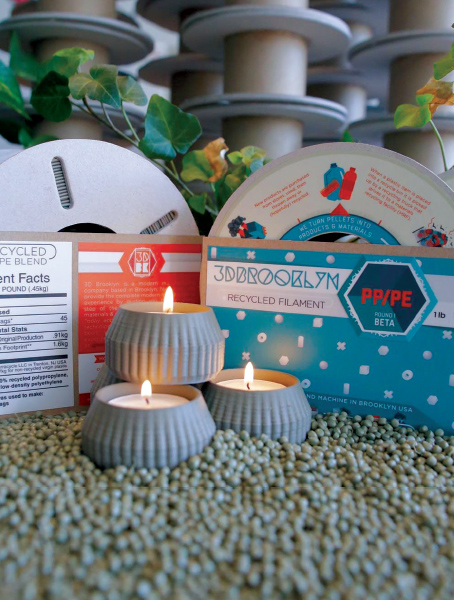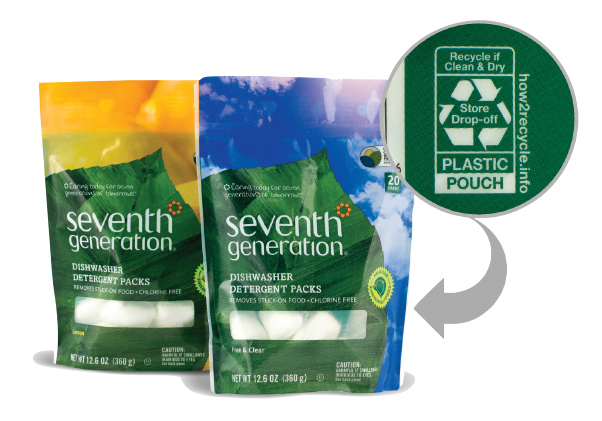Recycling the Unrecyclable
Industry innovations aim to keep traditionally difficult-to-recycle plastics out of the landfill
Previous Article Next Article
By Nancy D. Lamontagne
Recycling the Unrecyclable
Industry innovations aim to keep traditionally difficult-to-recycle plastics out of the landfill
Previous Article Next Article
By Nancy D. Lamontagne
Recycling the Unrecyclable
Industry innovations aim to keep traditionally difficult-to-recycle plastics out of the landfill
Previous Article Next Article
By Nancy D. Lamontagne

3D Brooklyn and TerraCycle worked together to produce a 3-D printer filament made from recycled potato chip bags (photo courtesy of 3D Brooklyn).

These new all-polyethylene stand-up pouches can be recycled at plastic bag recycling bins found at stores across the country (photo courtesy of Accredo Packaging).

Logistics and legacy chemicals pose the biggest hurdles to recycling PVC-based durable goods, such as the vinyl tile being ground up here (photo courtesy of Tarkett).
Although the amount of plastic that is recycled has grown tremendously in the last few decades, some materials and products still pose challenges. Through education, technology advancement, and creative approaches, the plastics industry is finding ways to keep even more plastics out of landfills.
From Chip Bags to 3-D Printing
TerraCycle, Inc. is known for turning difficult-to-recycle items such as drink pouches and used coffee pods into useful products. One of its newest endeavors involves creating raw materials that can be used in 3-D printing from potato chip bags, which are difficult to recycle because they are made from a blend of polypropylene (PP) and polyethylene (PE).
The recycling process begins with TerraCycle collecting the chip bags through its recycling program, removing any contaminants, and then shredding the bags and compressing them into a solid material. This solid material is extruded into plastic pellets that remain a PP/PE mix. TerraCycle’s partner, 3D Brooklyn, melts the plastic pellets and forms them into a plastic filament for 3-D printer machines.
In addition to being used for the 3-D printer filament, TerraCycle also processes the PP/PE pellets into new plastic products such as park benches, picnic tables, and recycling bins. “As with any recycling process, the main concern was maintaining strength and durability in the final product, which we were successful in doing,” says TerraCycle’s Colleen Duncan. “Our partnership with 3D Brooklyn has expanded our opportunities to create new products from material otherwise destined for the landfill.”
3D Brooklyn uses the filament to print its own products and has also sold or given schools or beta testers 80 spools that each contain a pound (0.45 kg) of filament. “We were pleasantly surprised at its popularity, although we probably shouldn’t have been; the maker community has a history of getting behind novel ideas like this,” says Nate Kolbeck, CEO and co-founder of 3D Brooklyn.
The company plans to launch a Kickstarter project to help pay for the manufacturing of another batch of the recycled filament. 3D Brooklyn is also expanding its recycled 3-D printer filaments to include ones made from recycled high-density PE from plastic milk jugs and yogurt cups.
“These types of approaches to manufacturing are core to our brand identity and our company vision,” says Kolbeck. “We are pioneering manufacturing techniques for a new world. By developing ways to work with bioplastics and recycled plastics instead of oil-based plastics, we are taking steps in a greener direction that will become more and more relevant in the coming years.”
A Recyclable Stand-Up Pouch
Stand-up pouches are growing in popularity due to their resealable convenience and customizable packaging. However, most pouches are made of multiple layers of different materials, rendering them difficult or impossible to recycle.
A recent collaboration between The Dow Chemical Company’s Packaging and Specialty Plastics business, the Sustainable Packaging Coalition (SPC), Accredo Packaging, and Seventh Generation has produced a new recyclable stand-up pouch. It will replace laminate pouches made with a traditional polyethylene terephthalate (PET)/ink/adhesive/linear low-density PE structure that was previously used for packaging Seventh Generation’s Dishwasher Pods.
“The new stand-up pouch takes us from co-mingled structures with multiple material ingredients to multi-layer, single-source structures that don’t need to end up in landfills,” says Stacy Fields, North American director of Packaging Solutions at Dow. “For Dow, these types of collaborations with converters, brand owners, and others in the value chain to drive packaging innovation are common and help us develop packaging that end users demand.”
Historically, multi-material, multi-layer pouch development involved the use of different types of materials for each layer. PET, PP, or biaxially oriented nylon are still often used to provide functionality such as stiffness, temperature resistance, barrier properties, and surface finish, and PE is used to provide toughness and sealability. But the films that result from those combinations aren’t handled by the PE recycle stream.
Derrick Lawrence, director of packaging development at Seventh Generation, explains that the main challenge for this project was developing materials that provided functional and aesthetic attributes similar to those of the previous pouch. In particular, the clarity and gloss of the new PE-based structure needed to match that of the previous PET-based pouch. Malcolm Cohn, director of sustainability at Accredo Packaging, Inc., points out that the necessary sealability, stiffness, toughness, temperature resistance, and gloss properties are difficult to attain using PE only.
Bringing together Dow’s RecycleReady™ resin technology with new processing approaches developed by Accredo were key for making a multi-layer pouch made completely out of PE. The resulting AccredoFlex® RP™ recyclable pouch has a structure made of multilayer PE coextrusions and solventless laminated adhesive.
“We believe the AccredoFlex RP all-polyethylene stand-up pouch has the potential to be an ‘industry changer,’ moving from multi-material structures whose end-of-life will be landfill, to a single-source, homogeneous substrate that can be recycled and so diverted from landfill,” says Accredo’s Cohn.
Another challenge with recycling stand-up pouches and other types of film packaging is ensuring that consumers know where to recycle them. Plastic bags, films, and wraps are typically not accepted in curbside recycling bins, but stores across the country have plastic-bag recycling bins that accept these items. The new dishwasher pod packs feature the “How2Recycle” label, which alerts consumers to take the pouches to one of these drop-off locations for recycling.
GreenBlue’s Sustainable Packaging Coalition began the How2Recycle Label project in 2008 to provide consistent on-package recycling information to consumers. Research has shown that most people don’t understand resin identification codes, which were never intended to communicate recyclability to the public. The label helps to overcome this confusion and addresses variations in local recycling programs that make proper recycling a challenge.
Keeping PVC Out of the Landfill
Polyvinyl chloride (PVC) is another material that has faced some recycling challenges. Originally developed on an industrial scale as a way to deal with the chlorine byproduct of caustic soda and potash production, PVC is used today in consumer goods as well as durable goods such as window frames, pipes, and flooring. Diane Martel, vice president of Environmental Planning and Strategy for flooring manufacturer Tarkett, says that logistics and legacy chemicals pose the biggest hurdles to recycling PVC-based durable goods.
The logistics issues arise because even though it’s possible to form direct agreements with end-users to send back PVC-based flooring materials, it can be difficult to find economical and environmentally friendly ways to transport recovered flooring from all over the country, or even the continent, to flooring plants in the Midwest or on the East Coast. “Working with a small quantity of returned materials is not efficient and brings a high cost on the economical side and also on the environmental side,” explains Martel.
To solve the logistics issue, the company began to establish consolidation points across the USA, with Tarkett’s distributors acting as many of these consolidation points. In the last three years, the company covered 60% of the country in this way and continues to work towards complete coverage.
For many years PVC was manufactured in a way that used phthalate-based plasticizers and heavy metal stabilizers. Some older PVC flooring even contains asbestos, which prevents it from being recycled at all. Tarkett avoids legacy chemicals by keeping a close watch on the chain of custody for the recycled material. The company ensures any resilient flooring made from recycled content contains less than 1,000 parts per million of phthalates—the level defined by the U.S. Environmental Protection Agency as acceptable for toys for children as well as for food contact.
“We have clear specifications on what is acceptable for a finished good, and strict commitments and processes for both soft and resilient flooring,” Martel says. “We also have questionnaires and audits for our suppliers that ensure that they have their own environmental policies.”
Thanks to its innovative approach to recycling, Tarkett has recycled 115,516,048 pounds (52,397,197 kg) of resilient flooring and 64,270,112 pounds (29,152,432 kg) of carpet tile since 2010. “When we look at PVC, what we are making today is what we will be using as materials in the future, so it is important that it is made with safe and good materials that are responsible towards the climate and also people,” Martel says.
“Looking ahead, I think it is really important to look at and try to implement new ways of recycling and using this product. I am sure within the next ten years there will be new technology appearing to ease the process of recycling PVC, especially in terms of extracting it from the additives and fillers.”